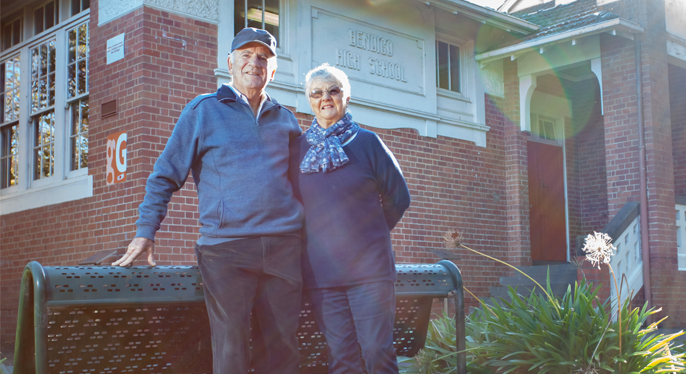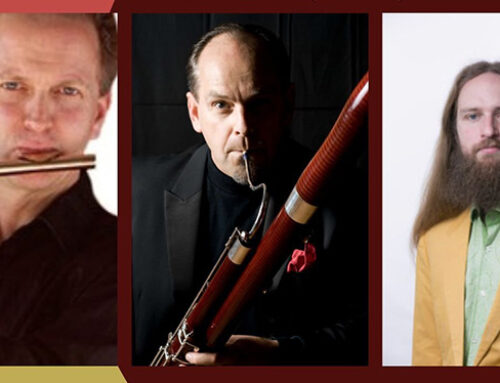Ruth Paynter (nee Brown) Bendigo High 1953-1955
Geoff Paynter – Bendigo High 1951-1956
In 1956, Ruth Paynter was in her first year of primary teacher training in Melbourne and like so many people, was very excited to attend the 1956 Melbourne Olympics. Bendigo High School actually delayed its matriculation exams so that students, like Ruth’s husband-to-be, Geoff Paynter, could also attend. Geoff, who was an avid sportsman himself—a 75 yard and 220 yard runner and captain of the school football team—has clear recollections of watching athletics at the MCG, including the ‘Landy mile’.
But Geoff wanted to be an artist—and had wanted to since late primary school.
“In 1949, when I was in Grade 4, polio became an epidemic,” Geoff says. “I didn’t get polio, but I was in and out of hospital that year—and I did heaps of drawing. I knew from then on I wanted to be an artist.”
Geoff’s memories of his time at Bendigo High include singing the school song at each assembly, accompanied on piano by Gwen Bowles, who later became principal at Mac.Robertson Girls’ High School.
“The principal during our time at the school was Mr Rupert J. H. Crocker,” Geoff says. “We were always very respectful of him, but it wasn’t that we were terrified of him. The school didn’t use the strap to discipline kids.
“The worst thing I could remember happening was detention, which was considered quite shameful. Interestingly, because of this, it did not occur to me to use the strap when I was a teacher.”
One of the funnier moments Geoff remembers happened in French class, with teacher Wilfred Goldsmith.
“He was a very prim and proper Englishman, and this particular day he announced that all the boys were to be detained at 4pm. We were all waiting with baited breath when he announced in his perfect English accent, ‘I think there is faaaar too much faaaarting in this claass.’ We were all beside ourselves. It was incredibly funny but none of us were game to laugh out loud.”
Art was a core subject for the first two years at high school, then in form three students had electives.
“I chose to do woodwork and metalwork, rather than languages or maths,” Geoff says. “It was a way of keeping involved in more creative subjects closer to art. In forms five and six I did Geology as well.”
Ruth, Geoff’s future wife, was also at the school. They met in the school ground and Geoff insists it was love at first sight.
“I used to wait at the bike racks for this really good looking girl who had moved from Shepparton and happened to ride her bike to school,” he says with a smile.
Reminiscing about her classes and teachers, Ruth remembers that Miss Groom, the English teacher, chose fantastic books and inspired a deep and lifelong love of reading.
History classes, on the other hand, were dreadfully dull. Miss Florence Anderson (known as Fanny and an ex-student herself) would stand at the front of the class and read out of the history text for the entire period.
“We wrote furiously for the whole time,” Ruth remembers. “It must have worked. I still love history and when Geoff and I travel we love visiting sites I first heard about in Miss Anderson’s class.”
But Ruth did not have the same career options that were available to Geoff.
“I wanted to be a kindergarten teacher, but back then you had to pay for the course,” she says. “Although I was a prefect in Form 5, I was also the eldest of five children and money was tight. So I left at the end of form five with a studentship and had two years at Melbourne Teachers College—and lived at the teachers college hostel in Brighton. My first school was Blackburn State School and then I married Geoff and we moved to Leongatha.”
Meanwhile, as Geoff moved through secondary school, he realised how hard it would be to make a living as an artist.
“I decided that if I became an art teacher I would have a career and still be able to paint,” he says.
As with Ruth, Geoff was given a studentship from Melbourne Teachers College.
“I wanted to stay in Bendigo because I was captain of the South Bendigo Football Team,” he says. “A compromise was to enrol in art school at the Bendigo School of Mines, then complete my final year of teacher training in Melbourne.”
In 1960, now married to Ruth and living and teaching in Leongatha, Geoff was awarded the Bendigo Art Prize. The competition was judged by Lloyd Rees.
During the nine years the Paynters were in Leongatha, Geoff took study leave to complete a Diploma of Art and Design. This brought him both a promotion and further skills to enhance the unusual role that was soon to follow. Geoff and Ruth moved back to Bendigo and Geoff took up the role of Education Officer at the Bendigo Art Gallery—a position funded by the Victorian Education Department to promote the Bendigo Art Gallery and art in general to local schools.
Ruth, with deep connections to Bendigo, through her mother being part of the Lansell family, was quite happy to be back in Bendigo.
“Bendigo Art Gallery was managed mostly by volunteers back then,” Geoff remembers. “There was much goodwill, but not always great expertise in evaluating art.
“Some of the volunteers showed me a damaged canvas that they wanted to throw away. I had a look at it and recognised the style. ‘I think that’s a John Glover,’ I told them, which it was. I still feel a great connection to that painting—now safely preserved at the Gallery.
“The only time I actually taught at Bendigo High School was while I was employed at the gallery. I took the Form 6 Art class for a term while their teacher was on long service leave.”
After three years Geoff returned to teaching, firstly at Golden Square, then Flora Hill and later became principal at Eaglehawk. His and Ruth’s four children all attended Bendigo High School.
BSSC’s Old Gold alumni/alumna organisation was formed in the mid-1990s. Ruth and Geoff were founding members. The group has been the driving force behind setting up a process, base and a place to archive valuable memorabilia—in the original principals’ office—and the establishment of the ‘history walk’. Geoff was president of Old Gold during the school’s 90th Anniversary celebrations in 1997.
When asked if kids are different today to when he was teaching, Geoff says, “Most kids respond well to being treated consistently and fairly. I don’t think that ever changes.”












